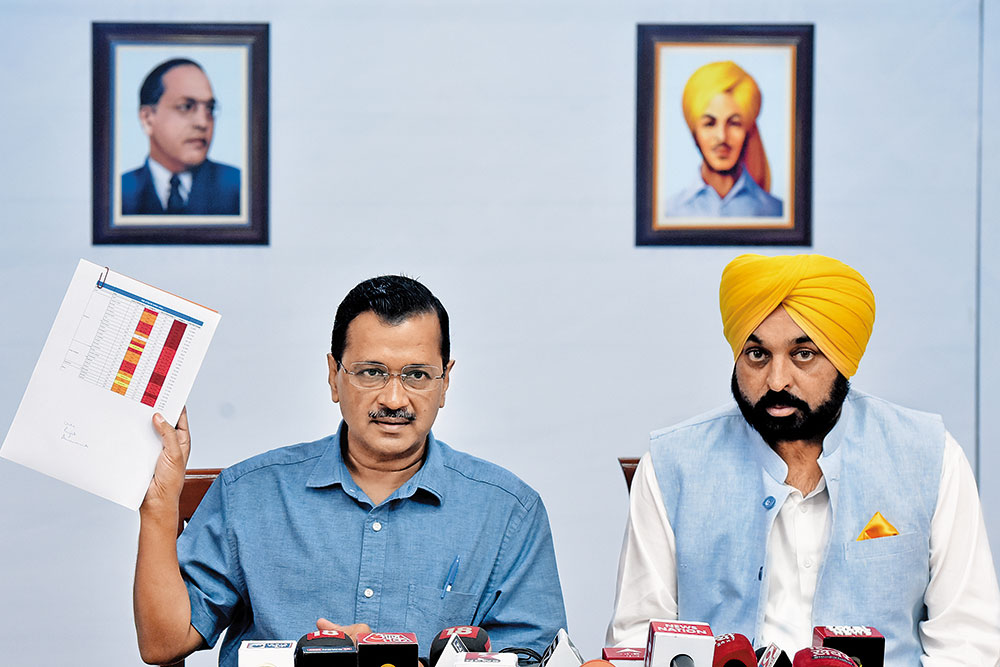Arvind Kejriwal’s Aam Aadmi Party (AAP) has turned a decade old. When Kejriwal separated from social activist Anna Hazare, his goal was clear: he and others in the leadership wanted to make AAP as a reliable opponent to the Bharatiya Janata Party (BJP), which was on the ascendent, and the Congress.
The initial response that AAP got from the people of Delhi in the 2013 assembly election must have convinced its founders that the country was ready for it. The hype in urban centres justified this optimism, which prompted its leadership to field Kejriwal against Narendra Modi in Varanasi in the 2014 Lok Sabha election. Kejriwal lost the election to Modi but not before creating a buzz around his candidature, with people from across the country landing in Varanasi to passionately campaign for him.
AAP did not do well in the General Election, but its performance could have been interpreted either ways—as a party finding its feet or spreading itself too thin. After all, Kejriwal was still an urban legend of sorts and the party had a left-of-centre image.
Many members of the party had conceptualised AAP as a national force occupying a left space with the help of grassroots movements and the intellectual class. Around the time Kejriwal carried the purge of this class of leaders, Modi as prime minister was successfully turning the national discourse rightward by consolidating his hold over national institutions. At the same time, he almost paralysed Kejriwal’s governance structures within the Delhi government.
With the left-leaning leadership gone and sensing the consolidation of a right-wing narrative in the country, Kejriwal lay low before slowly vacating any ideological space his party had aimed for. A side effect of this withdrawal and Modi’s aggression was that AAP had lost control over its national narrative. Even Punjab, the only success story it had outside of Delhi, looked a lost cause with the exit of H.S. Phulka from the party. By then, AAP leaders had stopped targeting Modi or raising corruption-related issues.
Things started changing for AAP in 2020 when it defeated the BJP in a direct fight in the assembly election, winning 62 seats in the 70-member assembly.
However, AAP would wait longer before it could go national again. It sat out the two anti-Modi movements in the Citizenship (Amendment) Act protests and anti-farm law protests. It waited for all and sundry opposition leaders, like West Bengal chief minister Mamata Banerjee and Telangana chief minister K. Chandrashekar Rao, to mount attacks on Modi after their respective victories in state assemblies.
Despite the spectacular victories of these state satraps, none of them had any influence outside their states. This is what set AAP apart after it defeated the Congress in Punjab earlier this year. Suddenly, Kejriwal was the only other leader who mattered in the opposition after Rahul Gandhi who could challenge Modi on a national stage.
However, unlike Gandhi, Kejriwal keeps the party to a non-ideological, service-driven model of politics. “There is a real demand for Kejriwal’s model of governance in the country. Our focus is and will always remain health, education, environment, women empowerment and economic stability,” AAP spokesperson Abhinandita Dayal Mathur says, underlining where the party’s appeal lies. Its national spokesperson Raghav Chadha is more direct. Talking about the party’s Gujarat campaign, he says, “Sadly, even after 75 years of independence, we are still debating and fighting for the basic right of the common man. The AAP model of governance is about giving back to the people. We are reshaping the political landscape of the country.”
The year 2022 brought back the national in AAP. Incidentally, this is also the time when Gandhi is trying to up his stake in the opposition space with the Bharat Jodo Yatra, whose clear message is secularism. The national opposition space is now neatly divided between Kejriwal’s ideology-free politics and Gandhi’s inclusion pitch, both wanting to dislodge Modi from his right-wing perch.











